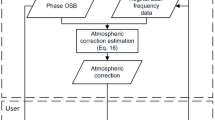Abstract
The Beyond Einstein Advanced Coherent Optical Network (BEACON) mission was designed to achieve an accuracy of \(10^{-9}\) in measuring the Eddington parameter \(\gamma \), which is perhaps the most fundamental Parameterized Post-Newtonian parameter. However, this ideal accuracy was just estimated as a ratio of the measurement accuracy of the inter-spacecraft distances to the magnitude of the departure from Euclidean geometry. Based on the BEACON concept, we construct a measurement model to estimate the parameter \(\gamma \) with the least squares method. Influences of the measurement noise and the out-of-plane error on the estimation accuracy are evaluated based on the white noise model. Though the BEACON mission does not require expensive drag-free systems and avoids physical dynamical models of spacecraft, the relatively low accuracy of initial inter-spacecraft distances poses a great challenge, which reduces the estimation accuracy in about two orders of magnitude. Thus the noise requirements may need to be more stringent in the design in order to achieve the target accuracy, which is demonstrated in the work. Considering that, we have given the limits on the power spectral density of both noise sources for the accuracy of \(10^{-9}\).



Similar content being viewed by others
References
Will, C.M.: Theory and Experiment in Gravitational Physics, 2nd edn. Cambridge University Press, Cambridge (1993)
Will, C.M.: Living Rev. Relativ. 9, 3 (2006)
Turyshev, S.G., Shao, M., Girerd, A., et al.: Int. J. Mod. Phys. D 18, 1025 (2009)
Turyshev, S.G.: Usp. Fiz. Nauk. 179, 3 (2009)
Turyshev, S.G.: Phys. Usp. 52, 1 (2009)
Reasenberg, R.D., Shapiro, I.I., MacNeil, P.E., et al.: Astrophys. J. Lett. 234, L219 (1979)
Fomalont, E., Kopeikin, S., Lanyi, G., Benson, J.: Astrophys. J. 699, 1395–1402 (2009)
Bertotti, B., Iess, L., Tortora, P.: Nature 425, 374 (2003)
Turyshev, S.G., et al.: Exp. Astron. 27, 27 (2009)
Braxmaier, C., Dittus, H., Foulon, B., et al.: Exp. Astron. 34, 181 (2012)
Pierce, R., Leitch, J., Stephens, M., et al.: Appl. Opt. 47, 5007 (2008)
Coddington, I., Swann, W.C., Nenadovic, L., et al.: Nat. Photonics 3, 351 (2009)
Acknowledgments
This work is partially supported by the National Natural Science Foundation of China (Grant Nos. 11175160, 11275075, 11575160).
Author information
Authors and Affiliations
Corresponding author
Rights and permissions
About this article
Cite this article
Luo, J., Tian, Y., Wang, DH. et al. Measurement of the PPN parameter \(\gamma \) by testing the geometry of near-Earth space. Gen Relativ Gravit 48, 73 (2016). https://doi.org/10.1007/s10714-016-2066-x
Received:
Accepted:
Published:
DOI: https://doi.org/10.1007/s10714-016-2066-x




